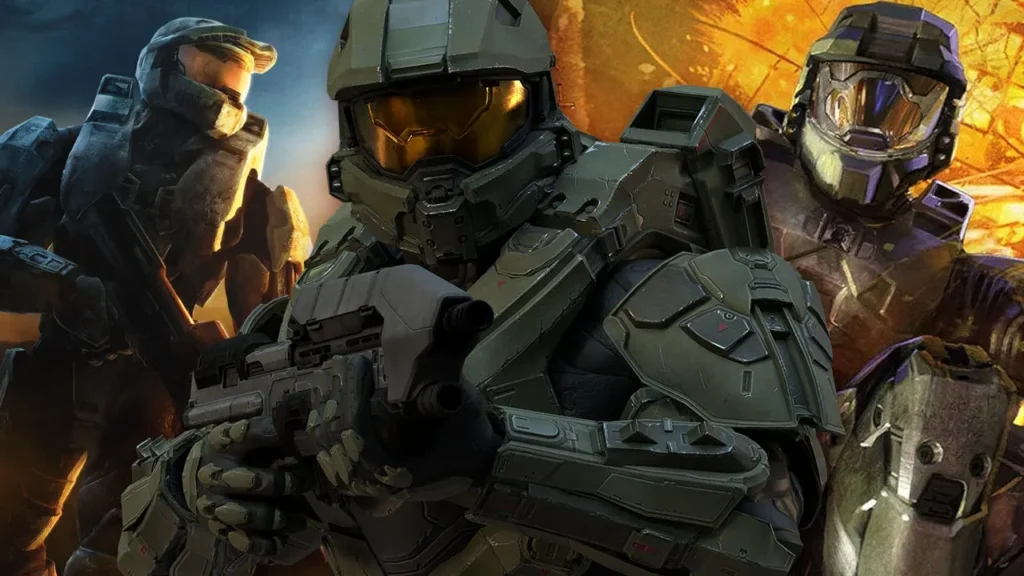When Halo: Combat Evolved was released in 2001, few could have predicted the immense impact it would have on the gaming industry. By 2003, Halo had firmly established itself as a cornerstone of console gaming, revolutionizing the first-person shooter (FPS) genre and laying the groundwork for future games. The Halo (2003) Game is often remembered for its iconic gameplay moments, groundbreaking mechanics, and multiplayer experiences that shaped a generation of gamers. This retrospective delves into those key elements that made the Halo (2003) Game such a monumental success.
The Beginnings of a Revolution: Halo: Combat Evolved
At its core, Halo: Combat Evolved is a story of survival, conflict, and discovery, with the player taking on the role of Master Chief, a Spartan super-soldier fighting against the alien Covenant. When Halo launched in 2001, the gaming landscape was dominated by PC shooters like Quake and Unreal Tournament, with consoles struggling to find their place in the genre. The introduction of Halo changed everything, as it set a new standard for FPS titles on consoles.
By 2003, Halo had achieved legendary status. Its innovative controls, using the dual analog sticks of the Xbox controller for movement and aiming, provided a smooth experience that hadn’t been achieved before on consoles. This control scheme became the template for nearly every console FPS that followed. Halo also boasted a compelling storyline with rich lore, giving players a reason to care about the characters and the universe in which they found themselves. These elements, combined with technical advancements in graphics, audio, and artificial intelligence, solidified Halo (2003) Game as a pioneering title.
The Story and Setting: A Sci-Fi Epic Unfolds
The narrative of the Halo (2003) Game is set in the 26th century, where humanity is locked in a war with the Covenant, a coalition of alien species bent on the destruction of humanity. As Master Chief, players must navigate the ringworld known as Halo, an ancient structure built by a long-lost race called the Forerunners. The mystery surrounding Halo’s true purpose is gradually revealed throughout the game, leading to a climactic showdown that left players clamoring for more.
In 2003, Halo continued to be lauded for its intricate world-building. The ringworld itself was a character in its own right, with its sprawling landscapes, alien architecture, and hidden secrets. Players were given vast environments to explore, each with its own distinct feel, ranging from lush jungles to foreboding underground complexes. This diversity in level design not only kept the game fresh but also allowed for different strategies in combat.
What truly set the Halo (2003) Game apart from other titles was the way it balanced narrative and gameplay. While many shooters at the time focused solely on fast-paced action, Halo took the time to develop its story, making players feel invested in Master Chief’s journey. Cortana, the AI companion, provided critical information and banter, offering a humanizing element to the super-soldier’s otherwise stoic demeanor.

Iconic Gameplay Mechanics: Setting the Standard for Future FPS Titles
One of the defining features of the Halo (2003) Game was its innovative gameplay. Prior to Halo, first-person shooters on consoles often felt clunky, with developers struggling to translate the precision of mouse-and-keyboard controls to a gamepad. However, Halo solved this issue with its intuitive twin-stick control scheme, which made movement and aiming fluid and responsive. This innovation was groundbreaking at the time and became a hallmark of the franchise.
The Halo (2003) Game also introduced players to regenerating health, a feature that would later become ubiquitous in the FPS genre. Instead of relying on health packs scattered throughout the levels, Master Chief’s shield would recharge after a short period of avoiding damage. This mechanic encouraged players to adopt a more tactical approach to combat, using cover and planning their moves carefully.
Another key feature of the Halo (2003) Game was the introduction of vehicular combat. The game allowed players to pilot various vehicles, from the agile Ghost to the iconic Warthog. These vehicles added a new layer of strategy to the game, as players could traverse large environments quickly or engage enemies from a more mobile platform. The combination of on-foot and vehicular combat was seamless, making each battle feel dynamic and unpredictable.
The Unforgettable Campaign: Defining Single-Player Excellence
The Halo (2003) Game is perhaps best remembered for its campaign, which was packed with memorable moments. One of the standout missions, “The Silent Cartographer,” perfectly encapsulated the game’s strengths. Players were tasked with storming a beach and infiltrating a Covenant facility in search of a map room that would reveal the secrets of Halo. The mission’s open-ended design allowed for different approaches, whether players wanted to charge in with guns blazing or take a more tactical route.
Another unforgettable moment in the Halo (2003) Game was the introduction of the Flood, an ancient parasitic species that posed a threat not only to humanity but to the entire galaxy. The mission “343 Guilty Spark” started innocuously enough, with Master Chief exploring a seemingly abandoned facility. However, it quickly descended into chaos as players encountered the Flood for the first time. The sense of dread and panic as wave after wave of these relentless creatures attacked left an indelible mark on players, and the Flood would go on to become one of the franchise’s most feared enemies.
The Halo (2003) Game also featured one of the best finales in gaming history. In the mission “The Maw,” players had to escape the collapsing Halo ringworld in a thrilling race against time. The final Warthog run, where players had to navigate a crumbling structure while being pursued by explosions, remains one of the most exhilarating moments in gaming.
The Multiplayer Phenomenon: Birth of a New Era
While the single-player campaign of the Halo (2003) Game was exceptional, it was the multiplayer mode that truly cemented the game’s legacy. In an era before online gaming was widespread on consoles, Halo became a staple of LAN parties, where players would connect multiple Xbox consoles and engage in heated multiplayer matches. The game’s split-screen multiplayer allowed friends to team up or face off against each other, creating countless hours of fun.
The multiplayer maps in the Halo (2003) Game were meticulously designed, offering a range of environments that catered to different playstyles. “Blood Gulch,” with its vast open spaces, became a fan favorite for large-scale vehicle battles, while “Hang ‘Em High” offered tight corridors and vertical gameplay for more intense, close-quarters combat.
The introduction of game modes like Slayer, Capture the Flag, and King of the Hill gave players a variety of ways to engage with the game’s multiplayer component. These modes, along with the ability to customize match settings, provided endless replayability. The Halo (2003) Game effectively laid the groundwork for the future of online multiplayer, with its influence still seen in modern FPS titles.
The Legacy of Halo (2003) Game: A Timeless Classic
By 2003, Halo had already become a cultural phenomenon. Its success helped establish the Xbox as a legitimate contender in the console market, and the franchise’s influence extended far beyond gaming. The Halo (2003) Game set the stage for the launch of Halo 2, which would further revolutionize online multiplayer with the introduction of Xbox Live.
The legacy of the Halo (2003) Game can still be felt today. Its impact on the FPS genre is undeniable, with many of its innovations—such as twin-stick controls, regenerating health, and vehicle-based combat—becoming industry standards. Moreover, the game’s blend of storytelling, action, and atmosphere set a high bar for narrative-driven shooters.
Conclusion
As we look back on the Halo (2003) Game, it’s clear that its influence on the gaming industry is profound. From its innovative gameplay mechanics to its unforgettable campaign and groundbreaking multiplayer, Halo redefined what a first-person shooter could be on consoles. It introduced a generation of gamers to the possibilities of immersive storytelling and large-scale combat, creating a legacy that continues to shape the industry today. Whether you’re a veteran player who experienced the game firsthand in 2003 or a newcomer discovering it for the first time, Halo remains a timeless classic that stands as a testament to the power of video games to captivate and inspire.



